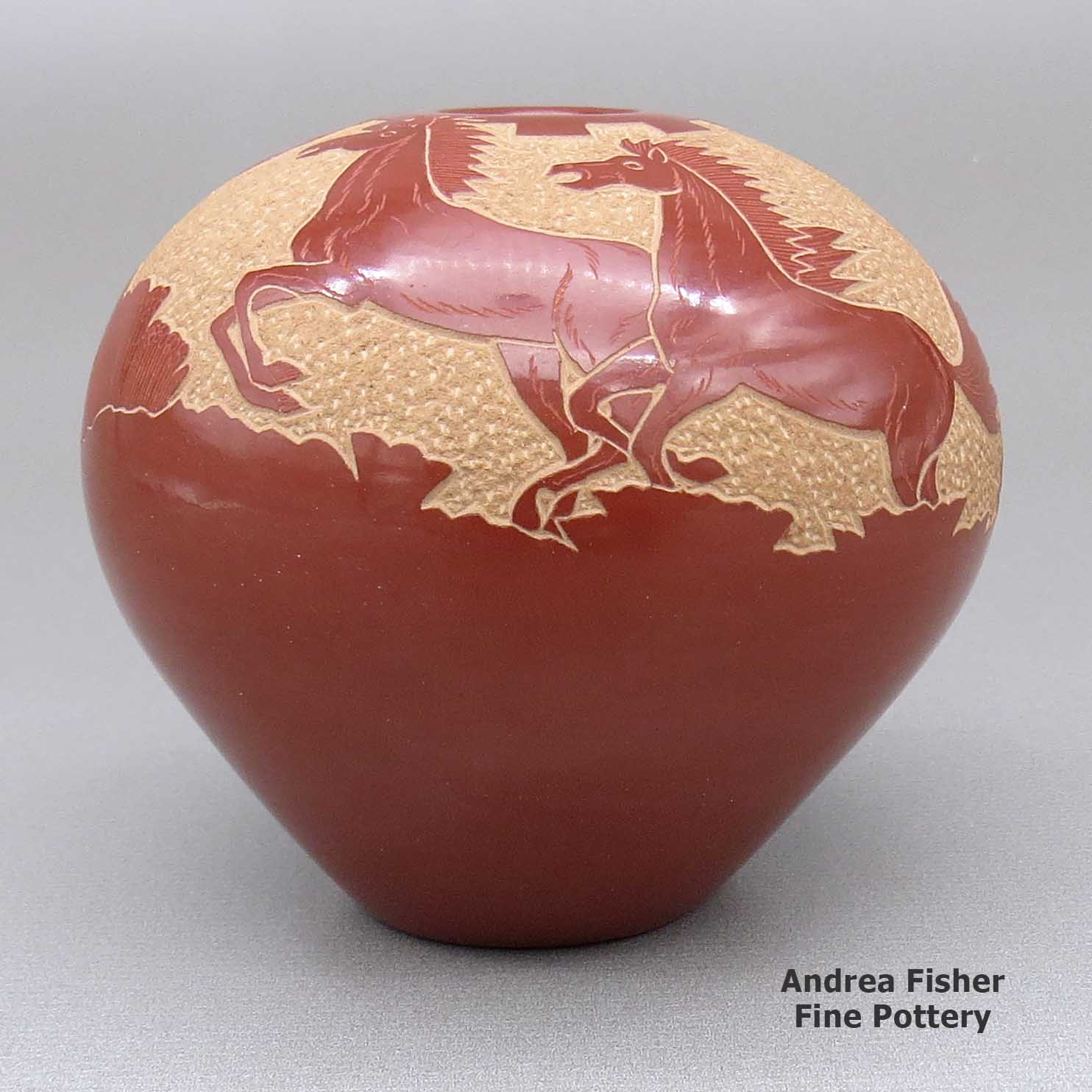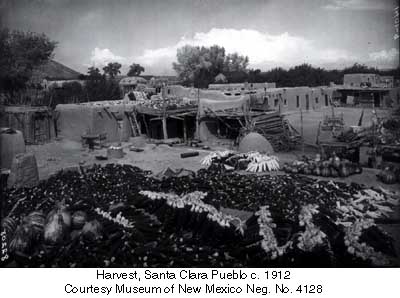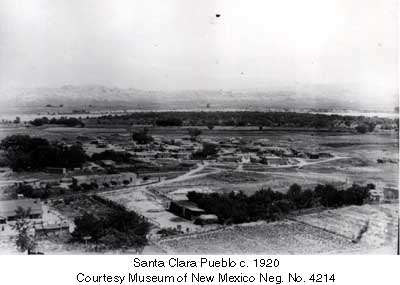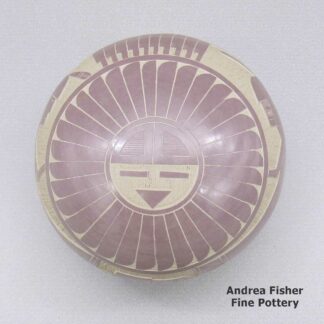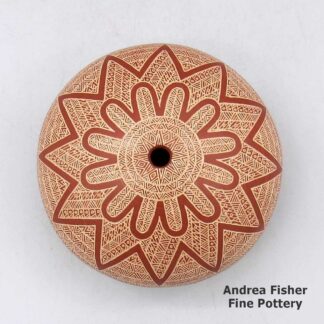| Dimensions | 3 × 3 × 3 in |
|---|---|
| Condition of Piece | Very good |
| Signature | Golden Rod |
Goldenrod, zzsc2m509, Seed pot with a wildlife and nature design
$825.00
A small red seed pot decorated with a sgraffito horse, sun face, quail, cactus and geometric design
In stock
Brand
Goldenrod
In 1942 World War II was on and Pojoaque Pueblo had been reestablished less than 10 years before. Living conditions were pretty rough and there was little infrastructure in place. When the Bureau of Indian Affairs in 1933 asked for information on where to find the Pojoaque people, many of them came out of Santa Clara. Those families had left Pojoaque during a smallpox epidemic when the Cacique (the pueblo's religious leader) died and the last Pueblo Governor left the area for work in Colorado, around 1908.
At Santa Clara, Petra's children grew up surrounded by a vibrant artist community and they learned to make pottery from some of the greats. Eventually, Thelma chose to move back to Pojoaque Pueblo after marrying Joe Talachy while Goldenrod and the others stayed at Santa Clara.
Today, Goldenrod freehand etches (sgraffito style) her hand-coiled seed pots with designs that often feature buffalo, corn maidens, rain clouds, deer, bear paws and birds. She earned First Place and Best of Division ribbons at Santa Fe Indian Market three years after she began making pottery.
Goldenrod's work has been featured in exhibitions all across the country. She was a participant at Santa Fe Indian Market for more than 20 years, earning more ribbons almost every year. The Smithsonian's permanent collection features some of her work. The Heard Museum says that Goldenrod has been an exhibitor at their annual Indian Arts Fair and Market every year since 2010.
Some Exhibits that Featured Goldenrod's Work
- Gifts from the Community. Heard Museum West. Surprise, Arizona. April 12 - October 12, 2008
- Choices and Change: American Indian Artists in the Southwest. Heard Museum North. Scottsdale, Arizona. June 20, 2007 - April 2012
- Images, Artists, Styles: Recent Acquisitions from the Heard Museum Collection. Heard Museum North. Scottsdale, Arizona. July 2001 - January 2002
Some Awards Goldenrod has Earned
- 2020 Heard Museum Guild Indian Fair & Market, Classification II - Pottery, Division G - Pottery miniatures not to exceed three (3) inches at its greatest dimension: Second Place. Awarded for artwork: "Wolves"
- 2017 Heard Museum Guild Indian Fair & Market, Classification II - Pottery, Division G - Pottery miniatures not to exceed three (3) inches at its greatest dimension: First Place. Awarded for artwork: "Black Bears"
- 2014 Heard Museum Guild Indian Fair & Market, Classification II - Pottery, Division D - Traditional, native clay, hand built, figurative: Second Place
- 2012 Heard Museum Guild Indian Fair & Market, Classification II - Pottery, Division G Miniatures not to exceed 3": First Place
- 2011 Heard Museum Guild Indian Fair & Market, Classification II - Pottery, Division G - Miniatures: Second Place. Shared with Preston Duwyenie 2004 Santa Fe Indian Market, Classification II - Pottery, Division K - Pottery miniatures, 3" or less in height or diameter, Category 1706 - Sgraffito: Third Place
A Short History of Santa Clara Pueblo

Santa Clara Pueblo straddles the Rio Grande about 25 miles north of Santa Fe. Of all the pueblos, Santa Clara has the largest number of potters.
The ancestral roots of the Santa Clara people have been traced to ancient pueblos in the Mesa Verde region in southwestern Colorado. When the weather in that area began to get dry between about 1100 and 1300 CE, some of the people migrated to the Chama River Valley and constructed Poshuouinge (about 3 miles south of what is now Abiquiu on the edge of the mesa above the Chama River). Eventually reaching two and three stories high with up to 700 rooms on the ground floor, Poshuouinge was inhabited from about 1375 CE to about 1475 CE.
Drought then again forced the people to move. One group of the people went to the area of Puyé (along Santa Clara Canyon, cut into the eastern slopes of the Pajarito Plateau of the Jemez Mountains). Another group went south of there to what we now call Tsankawi. A third group went a bit to the north, following the Rio Chama down to where it met the Rio Grande and founded Ohkay Owingeh on the northwest side of that confluence.
Beginning around 1580, another drought forced the residents of the Puyé area to relocate closer to the Rio Grande. There, near the point where Santa Clara Creek merged into the Rio Grande, they founded what we now know as Santa Clara Pueblo. Ohkay Owingeh was to the north on the other side of the Rio Chama. That same dry spell forced the people down the hill from Tsankawi to the Rio Grande where they founded San Ildefonso Pueblo to the south of Santa Clara, on the other side of Black Mesa.
In 1598 Spanish colonists from nearby Yunqué (the seat of Spanish government near the renamed "San Juan de los Caballeros" Pueblo) brought the first missionaries to Santa Clara. That led to the first mission church being built around 1622. However, the Santa Clarans chafed under the weight of Spanish rule like the other pueblos did and were in the forefront of the Pueblo Revolt of 1680. One pueblo resident, a mixed black and Tewa man named Domingo Naranjo, was one of the rebellion's ringleaders.
When Don Diego de Vargas came back to the area in 1694, he found most of the Santa Clarans were set up on top of nearby Black Mesa (with the people of San Ildefonso, Pojoaque, Tesuque and Nambé). An extended siege didn't subdue them but eventually, the two sides negotiated a treaty and the people returned to their pueblos. However, successive invasions and occupations by northern Europeans took their toll on the pueblos over the next 250 years. The Spanish flu pandemic in 1918 almost wiped them out.
Today, Santa Clara Pueblo is home to as many as 2,600 people and they comprise probably the largest per capita number of artists of any North American tribe (estimates of the number of potters run as high as 1-in-4 residents).
For more info:Pueblos of the Rio Grande, Daniel Gibson, ISBN-13:978-1-887896-26-9, Rio Nuevo Publishers, 2001
Upper photo courtesy of Einar Kvaran, Creative Commons Attribution-Share Alike 3.0 Unported License
About the Seed Pot
It was a matter of survival to the ancient Native American people that seeds be stored properly until the next planting season. Small, hollow pots were made to ensure that the precious seeds would be kept safe from moisture, light, bugs, reptiles and rodents.
After seeds were put into the pot, the small hole in the pot was plugged. The following spring the plug was removed and the seeds were shaken from the pot directly onto the planting area.
Today, seed pots are no longer necessary due to readily available seeds from commercial suppliers. However, seed pots continue to be made as beautiful, decorative works of art.
The sizes and shapes of seed pots have evolved and vary greatly, depending on the vision of Clay Mother as developed through the artist. The decorations vary, too, from undecorated white, buff or red seed pots to multi-colored painted, carved, applique and sgraffito designs, sometimes with inlaid gemstones, micaceous clay and silver or clay lids.
Because of the multitude of shapes and sizes, the name "seed pot" is generally reserved for pieces with tiny openings.
About Wildlife and Nature Designs
What we're calling "wildlife and nature designs" are usually quite contemporary designs carved, painted and/or etched by hand on a hand-made piece of pottery. In the same genre are bird, butterfly, dragonfly, moth, bat and fish designs. Some have seaweed and vines, some have trunks and branches, some have leaves and/or flowers and/or berries, some don't. Some are composed of optical illusions while others are very clear to the eye. While the designs and layouts tend to be quite contemporary, sometimes they incorporate elements of ancient settings.
Pasqualita Tani Gutierrez Family Tree - Santa Clara Pueblo
Disclaimer: This "family tree" is a best effort on our part to determine who the potters are in this family and arrange them in a generational order. The general information available is questionable so we have tried to show each of these diagrams to living members of each family to get their input and approval, too. This diagram is subject to change should we get better info.
Pasqualita Tani Gutierrez was the younger sister of Sarafina Tafoya. Their mother died shortly after Pasqualita was born and she grew up in Sarafina's home, alongside nieces Christina Naranjo, Margaret Tafoya and Dolorita Padilla, and nephew Camilio Tafoya.
- Pasqualita Tani Gutierrez Tafoya (1883-) & Severiano Tafoya
- Petra Montoya (Pojoaque, 1907-1992) & Juan Isidro Gutierrez (Santa Clara, 1901-1977)
- Gloria Goldenrod Garcia & John Garcia
- Desiderio Star Gutierrez & Genevieve Tafoya
- Debra Duwyenie & Preston Duwyenie (Hopi)
- Judy & Andrew Harvier
- Lois Gutierrez (1948-) & Derek de la Cruz
- Juan de la Cruz
- Thelma (1946-) & Joe Talachy (1940-)(San Juan/Ohkay Owingeh)
- Maria Minnie Vigil (1931-)
- Virginia Gutierrez (daughter-in-law of Petra, Nambe/Pojoaque)
- Gloria Goldenrod Garcia & John Garcia
- Tomacita Gutierrez Tafoya (1896-1977) & Cruz Tafoya (1889-1938)
- Cresencia Tafoya (1918-1999)
- Annie Baca (1941-)
- Pauline Martinez (1950-) & George Martinez (San Ildefonso) (1943-)
- Harriet Tafoya (1949-) & Elmer Red Starr (Sioux) (1937-)
- Ivan Red Starr (1969-1991)
- Norman Red Star (nephew) (1955-)
- Cresencia Tafoya (1918-1999)
- Maria Barbarita Naranjo & Jose Dolores Naranjo
- Mary Scarborough
- Veronica Naranjo
- Celestina Naranjo & Salvador Naranjo


